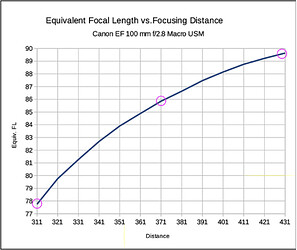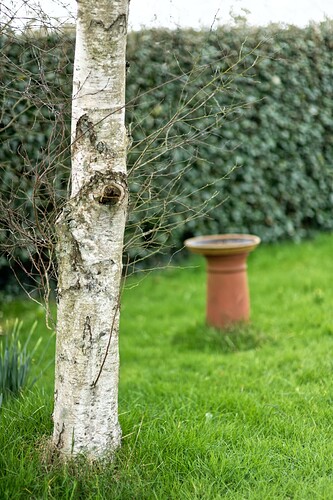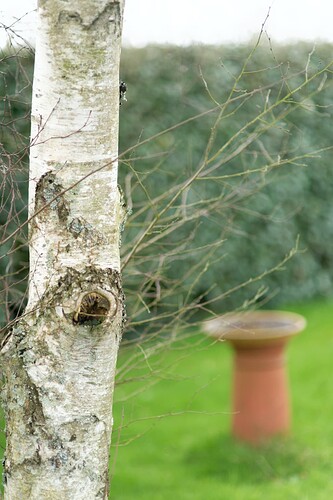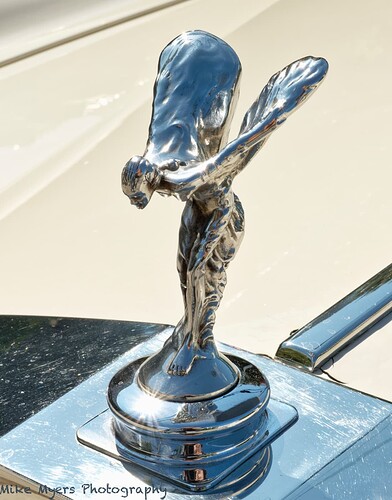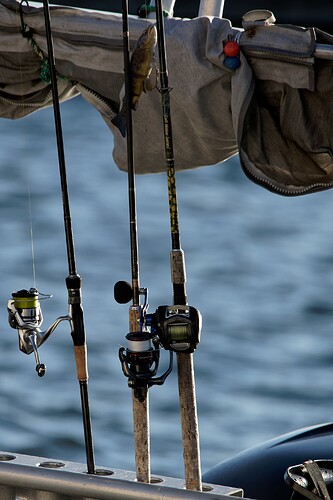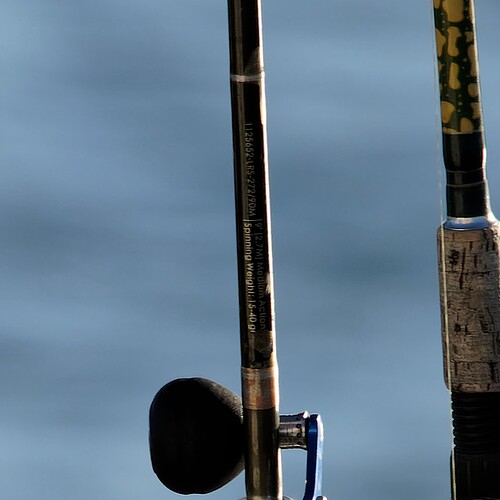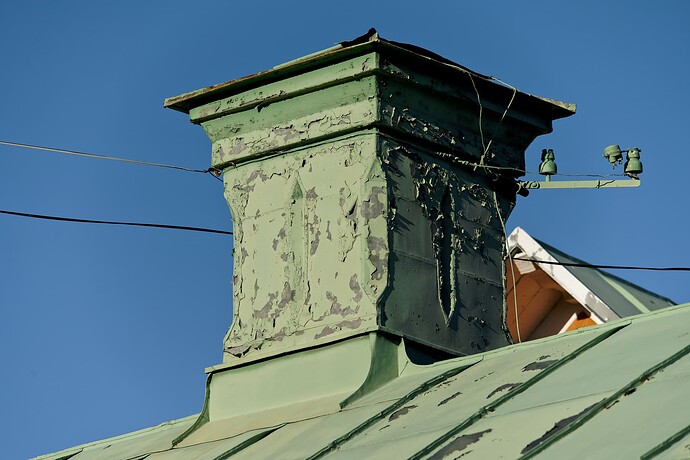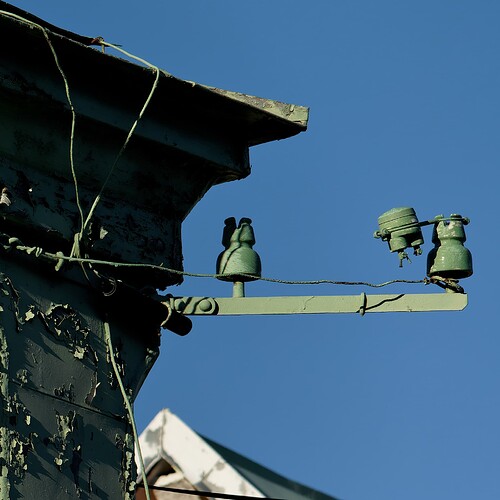@Joanna can life of a photog ever be too complicated? Normal people get a brush and a canvas, some oil paints and don’t mind about DoF (most of them could not paint a decent bokeh without eating a lot of onion rings).
He speaks the forbidden word! 

You can get the banhammer for life for this kind of Blasphemy.
I’ve come across this blog post before. Thank you for brightening my day by reminding me of it. I personally use glass hammers BTW 
Me too, Sigma Art mallets and a Gitzo Monopod as hammer handle. 
I use hammers with soft foam at the bottom of the head, much nicer feeling when you hit your own nail…
Lenses can have floating elements or not.
- Without floating elements, the focal length of a lens does not change.
- A lens with floating elements can change FL, unless it is breathing corrected.
What about DoF?
- Use the effective focal length - and more - to calculate DoF.
Check PhotoPills’ Macro DoF calculator.
Effective FL as measured for a Canon EF 100mm macro (the old one)
So, you have nails made just for you to put your furniture together and your get more satisfaction out of hitting them than regular nails? 


No fingernails, if you hit those you notice Immediately. No delay.

I know nothing about macrophotography. Are you saying these lenses, when used for regular photography, let’ say fom 30" to infinity, change their focal length as they are focused? Is this because strange things happen during macrophotography? …and as a follow-up question, why do they do this?
No, on the Fuji I’m not sure how to do much of anything. It does far too much of the thinking, one reason why I rarely use it. The other reason is I far prefer shooting with a full frame sensor, so my lenses work more like the way I expect them to work. That’s even more reasons to forget about the Fuji X-Pro 3 - I wasn’t interested any more last night, and now I’m even less interested. I think of my X100f as a fancy “box camera”.
How does that saying go, “Hindsight is always 20:20”? Yes, maybe that would have been a better idea. If I don’t pack the camera away again, maybe I’ll try that. I used the built-in ND filter in India, and it worked beautifully, but that was shooting something only a few feet away. I’m anxious to do what I first thought of doing, using a full frame camera that I do have control over, and shooting with the lens wide open. I guess I can do this lots of ways, for testing.
The Fuji X100f has a fixed lens. There is no real “zoom”. They sell add-on lenses for this purpose, but now you know why I put this camera in storage, along with my Canon G7X Pro Mk II, and stopped using the other than on rare occasions. I’m glad I did all this anyway, as it saved me from wasting $2,000 or so on the X-Pro 3, and even more for a lens, which I now realize is not for me. Watching the comparison test video also proved that to me: X-Pro 3 vs. M10
If I move away even further, bushes start blocking my view of this tree. I like that idea, but here, I couldn’t do it right - maybe if I had a ladder to get up high enough… No, not gonna happen. 
You also suggested moving sideways, to get a different background. I tried, and deleted it - I think it looked ugly because of the new background.
For better or worse, I’m pretty stubborn. I plan to try again.
Apparently things change considerably, when making lenses for macro photography, and I see no reason why a camera manufacturer couldn’t design a lens that does change focal length while you’re using it, but as far as I know, for my own photography, using common lenses from most of the lens manufacturers, the focal length is fixed.
There is a lot of stuff posted up above that I can’t relate to - to me, it’s no longer photography as I know it. I suggest this video explain s focal length very simply, and it applies to ever bit of camera gear I now own: Focal Length
The longer this discussion goes on, the less I’m interested in the new camera designs and gear that we’re expected to buy. I don’t want a mirrorless camera, for the reasons I’ve already posted, and I even more so do NOT want anything with “focus by wire”. I’m not even sure if I would want an electronic shutter.
To me, every one of these allows manufacturers to build camera gear less expensively. It all sounds like a bargain, even to me, until I start asking questions. Smaller sensors = smaller camera cost, leaving out the mechanical shutter lowers the cost to make the camera, leaving out the gears, etc., for mechanical manual focusing drops the cost. The cost to Canon/Nikon/Fuji/Sony keeps coming down. Then the advertising leads us to think all these are benefits. Maybe for some people, this is all good. I’m not one of them.
Everyone gets to make their own choice, but before making any choice, people should research not only what they’re “gaining”, but what they’re “losing”.
As to @platypus - you are right. Prime lenses that change focal length can be designed and manufactured, and maybe that’s the norm for macro-photography, but I don’t know if that technology is incorporated into new prime lenses for general photography. Maybe someone here can answer that?
PhotoPills doesn’t ask for the effective focal length, whatever that might be. It’s asking for the “effective f-number”.
The aperture number is (distance aperture to sensor)/(diameter aperture).
Under normal conditions the focal length can be used. The difference between focal length and image length is negligible. But not in makro. Nikon camera’s are showing the corrected, effective, aperture number. PhotoPills wants to know if the added aperture number is the effective aperture or not. Or in other words do they come frome a Nikon camera or not.
George
Out of interest, here are a couple of images of out tree, taken with my Nikkor 85mm f/1.4. It is blindingly sharp and, with an aperture of f/1.4, it is a lot easier to isolate stuff. I use it mainly for portraiture.
Taken at around 3m from the tree…
Taken at around 1.5m from the tree…
Notice how, with the second one, there isn’t even enough DoF for the whole tree trunk.
Changes in effective focal length is fairly common, but it shows most in macro lenses because of the wide range of distances they can focus on. You can’t see the effect with an optical viewfinder (e.g. on a Leica) but that does not mean that the effect does not exist. In general, FL changes can be ignored in photography except for less than general use like macro.
I rarely shoot formal portraits because I have too often found it difficult to please my subjects even though I’m shooting for free. Portraiture is just too much aggravation for me. I now leave it to those who actually get paid to deal with finicky clients.
The final straw a few years ago was when I was shooting a portrait of someone I did not know well as a favor to a friend. It was an outside shot, with a moderate amount of late afternoon light, taken in front of her garden, I was using a borrowed Canon 85 mm f/1.4 lens. I don’t recall if I was shooting wide open or stopped down a bit, but while she liked the way she looked, she complained that everything behind her looked “out of focus”. She asked if there was something wrong with my camera. I tried to explain to her about isolating the subject for portraiture, but it fell on deaf ears.
I took it again stopped down to either f/5.6 of f/8, raising the ISO quite a bit. This time she was happy with how sharp the background was, but was now disappointed that she blended in with it. That was it for me. I sent her Hi Rez jpeg versions of both shots. I never heard from her again, not even a “thank you”.
Mark
I took a third photo with the Fuji X100f the other day, but didn’t post it until now. Still not sure what to say about it. How do I make a sharp photo of something that is deliberately deigned to be the opposite of sharp? In this case, the hood ornament of a Rolls Royce automobile.
History:
- The hood ornament on a Rolls-Royce is called the Spirit of Ecstasy . This symbol goes back to 1909 when it was first sculpted. Only a few years later was it found on every Rolls-Royce model going forward.
So how to photograph it, and not get yelled at by the owner of the car…
- I tried with including the Rolls Royce emblem on the grill.
- I tried a bit closer, with more of the grill included.
- I finally (still not being yelled at) tried from a little bit closer, mainly looking at the hood ornament.
(The first time I photographed this car, I asked for permission. Now I get to see it almost every day, and I find it difficult to walk by, without taking a new photo…)
If I view it at 100%, I’m reasonably sure that it is properly “in focus”. @Joanna has such sharp eyes, she’ll perhaps contradict me. I tried from the opposite side, which was being lit by the sun, but didn’t like the result, so I went to this side, somewhat shooting into the sun. Everything looked more interesting.
I captured two photos, a side shot, and this one more from above. The side shot looked awful to me. I’m not sure if you will all look at this and wonder why I even bothered, or look at it and enjoy it? For me, the more difficult something is to photograph, the more I treat it like a challenge. But I still (suffer from) have my limitations. With a little retouching I know I can eliminate the cracks in the paint, but to me, ethically, that’s a no-no. I did other things I’m not supposed to do, like adjusting the vertical lines to eliminate the perspective view of looking down at the “Spirit of Ecstasy”. I think the final photo captured my emotions.
_DSF4645 | 2022-02-10.raf (48.0 MB)
_DSF4645 | 2022-02-10.raf.dop (13.7 KB)
Your example is just a parallell to what Sony photographers kan see in Sonys proprietary Imaging Edge View, Edit and Remote.
If you compare what you will see in Camera Raw with Imaging Edge it will be very similar to your example. Camera Raw doesn’t care about reading the metadata written to a RAW taken vith a BW-file “style sheet”, but the proprietary software does and some users see that a very important advantage.
The other problem is that some software doesn’t use ICC-profiles either.
Coming back.
@Joanna
A good example to verify that dof does not change if subject size does not change when changing focal lenght is to find a very well done dolly-zoom (rarely perfectly done because very hard to achieve - needs to perfectly synchronize dolly, zoom, and focus change, all 3 done by 3 or more different people at the same time -, and not always trying to keep a subject at constant size with focus on it).
I searched and find one very well done for our case : event horizon - 1997 (I’m absolutely not promoting this movie - didn’t see it - , just found that the dolly zoom is near from perfect.).
Here the character is very stable in size and focus is kept on him. What we need. We can see that background dof does not change. Only perspertive does.
Concerning sharpness and using old lenses on brand new cameras
The last weeks I have seen a few things that has been both expected, unexpected and even surprising using my old Sigma 150-500mm 5-6,3 APO OS on my brand new A7 IV. I haven´t used it for a while because of the pandemy
With my old A7 III I was never able to get the lens lock with eye focus over 400mm in low light. The A7 III also had a stop at f11 by design. With A7 IV I managed to get Eye Focus to lock with f22 in as low light as 83 lux which is about ¼ of the intensity an ordinary lamp bulb of 30W emits on one square meter. That gave an ISO of 12 800, an EV of 5,3 and a shutter speed of 1/10.
With A7 III I have felt the practical limit for ISO was 10 000 but with A7 IV I feel it´s Ok even with 12 800 but together with Deep Prime 12 800 with A7 IV is a non problem really.
Both these improvements have given this more than 10 year old lens a new and more useful life. I have used this lens on three or four safaris and have had problems occasionally with autofocus from time to time at game drives at dusk and dawn. Now it feels like this old Minolta A-mount lens on Sonys LAEA-3 adapter has got a new life. I were really close to give it away to my son but I have really changed my mind after a week of testing.
I´m also writing this because it might be of a more general interest even for Canon and Nikon photographers since even they now are facing a similar situation to what the Sony-photographers already have been through when they put their EF-lenses on the new R-camera houses.
I have read some Canon-people claims that old EF glass works as good as the new R-lenses on the mirrorless bodies, but I must say that there are a few things to test before conclusions like that can be drawn. A more than 10 years old lens like this Sigma was not constructed with R-bodies in mind as little as they were for Sony A7. So “works” is a quite wide concept as you will see in the text below but I´m sure they will experience a much more accurate auto focus than the ones in old DSLR:s. Lenses are children of it´s time and neither can a Sony A1 photographer or a Canon R3 one expect old lenses to be fast enough for 30 images per second. The compatibility list with suitable lenses for Sony A1 is about 20 lenses long of the about 350 lenses that has been manufactured up to this date for Sony E-mount. Even on Canon R people will experience that EF on adapters will not get the same fine sensor stabilization as people will get together with IS-stabilized lenses.
Below I will cover a few other conditions that have to be met to get my Bigma to deliver on an A7 IV. To my own empirics a also will refer to an old test by Kurt Munger who tested which stabilization methods to use
E-mount
Sony A7 II was the first Sony-kamera to get Sonys 5-ways stabilization with Sony E-mountlenses. In that case Roll, X and Y was managed by the camera och Pitch och Yaw in the lens.
E-mount without OSS-stabilization in the lenses gets 5 ways stabiliztion in camera but that was limited to just five new lenses at that time.
There are three different choises to chose between when using A-mount and LAEA-3 adapter on mirrorless bodies:
-
Sony Super Steady Shot (SSS) sensor stabilization (gives only three ways Roll, X and Y)
-
Sigma Optical Stabilization (OS) (gives Pitch, Yaw and sometimes even Roll)
Note! The lens can be set in three positions: OFF 1 (default at normal photography X-Y)) och 2 (when panning) -
SSS + OS on at the same time.
(It is practically possible to activate both BUT DON´T EVER since they will interfere with each other and ruin your images and give you hell since the EVF will not get stabilized properly)
- Manual lenses will also get stabilized BUT the user has to manually add the focal length used.
Note!
The tests I have done myself confirms that Sigma OS is more effective that SSS 3-way stabilization with long lenses like this one. SSS is the next best option if we just compares the image quality.
…. BUT is OS always the best choise? Read what Kurt Munger has to say:
"So which system is better? You’ll probably be quick to say the lens based system, but that might be a mistake. I noticed when using Sigma’s OS lens based system it takes more than a second to fully activate after it’s switched on, or is awakened by a shutter press, and if you quickly press the shutter button to take a picture, there may be little or no effect, so for fast action, make sure the system is active before you’re ready to shoot. The Sony SteadyShot system is ready instantly, and may produce better shots under certain circumstances. Note: Sigma claims a one second start-up time in their lens manual, but that’s not going to give you the best results based on my testing here.!
No simple rules here either!
“Sigma claims a one second start-up time in their lens manual, but that’s not going to give you the best results based on my testing here.!”
… BUT when I tested my lens it took more like three seconds to get the OS up and running properly to ensure optimal image quqlity. So if you don´t have that time SSS is a better choise since it´s instant.
I believe even Canon photographers have to make some empiric tests like we have had to do in order to find the best ways to use some of the old EF-lenses on the new camera bodies. Is there anyone that has read this and seen Kurt Mungers test below that believes untested that a Sigma 150-500mm 5-6,3 APO OS will work at least as good as a R-lens. Personally I have a little hard to believe that, even if I also believe that it still will be good enough for many users
Steady shot VS Sigma OS (kurtmunger.com)
Still I´m pretty impressed by how this old lens performs on my new camera body. Here a few example shots all taken with Sigma OS on:
Some winter anglers are out there in the archipelago fishing
Note the crop enlargement and how well we can read what´s printed on the fishing rod. 1125652 is what the serial number starts with. It’s a spinfishing rod for baits between 15-40 gram as you easily can see.
Data: 500mm, F8, 1/2000, ISO 1250
Image taken on a distance of about 15 meters
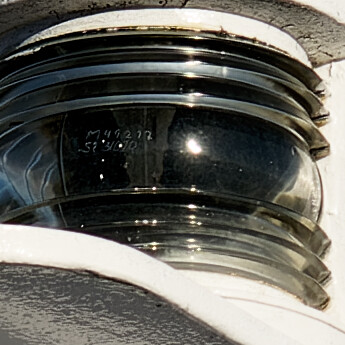
Ship lantern.
Note! If you look carefully you can see a few characters and numbers engraved in the glas of the lantern. M49217 at least I can see on the first row. I think I see a code like Si 401R on the row below.
Data: 160mm, F7,1, 1/640, ISO 100
Image taken on a distance of about 10 meters
Chimney
Data: 250mm, F8,1 /1250, ISO 400
Image taken on a distance of about 15 meters. Focus set on the right pair of isolators.
This lens has it´s sweet spot around this 250-300mm I believe but even at 500mm it´s surprisingly sharp at least at distances like 50-75 meters. This looks really over sharpened and that might be because it’s exported with bicubic sharpen method.
I think many users will find that the new A7IV produces images that are almost too sharp many times. It might be of that reason Sony has included a funkton to soften portraits in camera.
All image examples are taken hand held.
I shall also add that I normally never use AF-S (single shot focusing) anymore. Using AF-C here I think put the slow starting Sigma OS on a constant alert - and that we need. Today we have better batteries in our A7-cameras so for me it’s OK. It also activates face detection if you use Eye Focus and that works a little lika a pre-AF which might be useful too.

